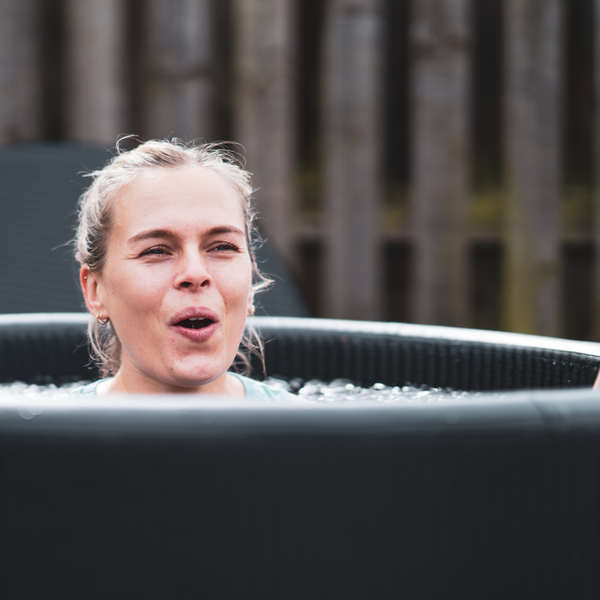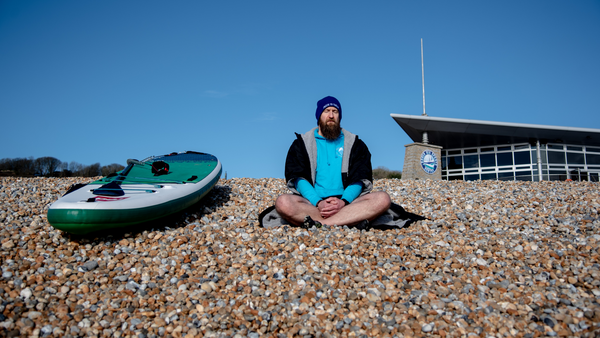Although there are no ‘specific’ guidelines about the ‘correct’ temperature for portable ice baths, there are suggested recommendations, depending on what you want to use it for.
Whether you’re a beginner or an avid expert, you’ll have the best idea about the right temperature and immersion time for you. But in this article, we’ll explore some of the recommendations based on some of the common reasons people use their ‘Cold Pod’.
What is an ice bath?
Ice baths are an example of cold-water immersion therapy, also known as cryotherapy. Cryotherapy has been around for centuries and is where exposure to cold temperatures is used as a therapeutic agent (Garcia et al, 2021). A simple example is applying an ice pack to a sprained ankle.
What are portable ice baths used for?
Portable ice baths are used for a variety of reasons and their popularity has rocketed in recent years. For many people, ice baths offer a versatile solution for various applications, and portable ice baths, like The Cold Pod, make cold water therapy accessible to everyone.
Some of the common reasons people use ice baths include:
- Sports/muscle recovery
- Injury rehabilitation
- Pain relief
- Stress relief
However, to reap the full benefits of ice baths, temperature is key.
The science behind temperature selection
Have you noticed how much of the ‘evidence’ around the optimal temperature for an ice bath is anecdotal? If you’ve scrolled the internet to find out the ‘perfect’ level of coldness for your plunges, you’ll know that there aren’t any universal guidelines that tell you the right temperature to aim for.
But there are recommendations based on why you may be using the bath. Some healthcare organisations and sports medicine specialists provide some general guidance, but there is one key piece of information to remember when taking an ice bath; everyone is different.
An individual’s response to cold temperatures can vary from someone else’s.
What temperature should my ice bath be?
Seeking the correct temperature for your ice bath is related to vasoconstriction.
Vasoconstriction is the body’s natural and often first response to being exposed to cold temperatures. It’s where your blood vessels narrow in response to the cold. This minimises heat loss by forcing blood deeper into the tissues and preserving its core temperature (Wigley, 2023).
The general consensus for taking an ice bath is that you should aim for a temperature between 10 and 15oC or 50 to 59oF, but these temperatures may vary based on your circumstances.
What does the science say?
Right now, there is no scientific evidence that completely supports the use of cold-water therapy. It’s not known if a specific temperature of duration in the water works best. There are also risks involved if you dip in colder water or stay in for longer, such as non-freezing cold injury. Where, when exposed to cold water, your hands and feet can become numb and tingle or feel painful when they warm up. In the past, it has been associated with cases of ‘trench foot’ but has more recently become a risk for cold water swimmers (Tipton and Eglin, 2023).
The point is different people will respond differently to cold water exposure. You should only stay in cold water for short periods and get out before you feel any discomfort, or numbness or your body starts to shiver. Going hard in this game isn’t necessarily the right thing to do.
Although evidence is limited, there is some research available into how effective cold-water immersion is for specific purposes and to attempt to ascertain the ‘optimal’ temperature to achieve the benefits.
Muscle recovery
A systematic review by Machado et al. (2016) investigated the effectiveness of cold-water immersion for treating muscle soreness. It also looked to identify the optimal temperature and immersion time for achieving the best results.
In total, nine studies were included in the review and found that immersion in cold water had a positive impact on both immediate and delayed muscle soreness compared to passive recovery. However, the review found that the effectiveness of cold-water immersion was influenced by certain parameters. In particular, the temperature of the water and duration.
Overall, the results showed that there was a dose-response relationship and that a water temperature between 11 and 15oC, and immersion for 11 to 15 minutes provides the best results for muscle soreness (Machado et al, 2016).
Pain relief
Like muscle soreness following exercise, some people look to use cold water immersion therapy to relieve pain. According to The National Institute for Health and Care Excellence (NICE), just under 28 million adults are affected by chronic pain in the UK (NICE, 2021).
A study by Kurniasari et al. (2022) investigated the effect of cold-water therapy on a range of parameters in acute gout patients, including pain, depression, stress, and quality of life. The study tested a cold-water immersion group using temperatures between 20oC and 30oC for 20 minutes each day for four weeks compared to a control group.
The results show that patients in the immersion group experienced significant improvements in several parameters, including:
- Reduced pain
- Improved joint mobility
- Increased physical activity leading to improved wellbeing
- Decreased anxiety, depression, and stress symptoms
- Notable increase in quality of life
Overall, the study showed that cold water immersion, even at warmer temperatures, can have positive benefits for pain relief.
Future considerations and conclusion
With cold water therapy and the use of portable ice baths on the rise, researchers are starting to understand the need for more research into their use and their benefits (Espeland et al, 2022).
We can see from the two notable studies in this article that the temperature of the water can be dependent on the use of cold-water immersion. For example, in the pain relief study, the immersion therapy was effective at temperatures between 20oC and 30oC. While for muscle recovery optimum temperatures were recorded between 11oC and 15oC.
Temperature control is the pivotal element that’s key to unlocking the potential benefits of The Cold Pod. It’s important to understand the physiological response of the body to different temperatures. We’ll be looking at more closely in this series. But in short: colder temperatures can cause the blood vessels to narrow, reducing inflammation. While warmer temperatures may promote relaxation, resulting in pain relief.
The way your body reacts to temperatures may also differ from other people’s and the ‘recommendations’ made by scientific studies and professional bodies. Listen to your body and find the temperature and duration that is comfortable and tolerable for you.
Garcia, C., Karri, J., Zacharias, N.A. et al. Use of Cryotherapy for Managing Chronic Pain: An Evidence-Based Narrative. Pain Ther 10, 81–100 (2021). https://doi.org/10.1007/s40122-020-00225-w
Kurniasari, M. D., Monsen, K. A., Weng, S. F., Yang, C. Y., & Tsai, H. T. (2022). Cold Water Immersion Directly and Mediated by Alleviated Pain to Promote Quality of Life in Indonesian with Gout Arthritis: A Community-based Randomized Controlled Trial. Biological research for nursing, 24(2), 245–258. https://doi.org/10.1177/10998004211063547
NICE. (2021) Chronic pain: How common is it? Available at: https://cks.nice.org.uk/topics/chronic-pain/background-information/prevalence/#:~:text=Between%20one%2Dthird%20and%20one,are%20affected%20by%20chronic%20pain.
Tipton, M and Eglin, C. (2023). Non-freezing cold injury: A little known big problem. The Physiological Society: 108(3), 329-330.
Wigley, F.M. (2023) Patient education: Raynaud phenomenon (Beyond the Basics), UpToDate. Available at: https://www.uptodate.com/contents/raynaud-phenomenon-beyond-the-basics/print#:~:text=Normally%2C%20the%20vessels%20that%20supply,internal%20or%20%22core%22%20temperature. (Accessed: 23 January 2024).







